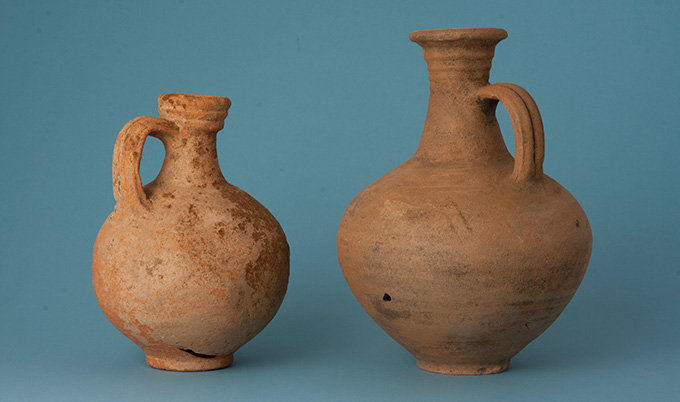Roman London’s cosmopolitan history revealed
Roman London’s cosmopolitan history revealed
Published on: 11 January 2016
London’s status as a global trading hub and melting pot of cultures dates as far back as Roman times, a new book reveals.
The changing face of a growing city
Bringing together more than 100,000 finds uncovered during one of the biggest excavations ever to take place in the capital, the book, ‘Temples and Suburbs’ captures the changing face of London over 400 years of Roman occupation.
Following 10 years of research into the artefacts unearthed at the Tabard Square site in Southwark, South London, archaeologists have found evidence that Roman London was as cosmopolitan a city as modern London, attracting people from all over the Roman Empire to live and work.
Although the site was slightly away from the core of the Roman city on the north bank of the Thames, it occupied a key location next to Watling Street giving easy access to Dover to the south.
As a result, there were trade connections with other parts of the Empire – archaeologists discovered artefacts which originated from Gaul (modern day France), Spain, and the Eastern Mediterranean, as well as evidence of people coming to London from other parts of Roman Britain.

Multicultural frontier town
Dr James Gerrard, co-author of the book and lecturer in Roman Archaeology at Newcastle University, said: "London at that time was probably akin to a wild west frontier town, with people from all over the Empire coming to London to seek new opportunities for themselves. In doing so, they brought with them new food, new languages and new cultures, and this is seen in many of the artefacts from the Tabard Square site.
“Its status as a burgeoning trading centre was also evident in the vast number of coins that were found including examples struck in not only Rome, but Trier, Lyon, Aquileia, Constantinople and the eastern Mediterranean.
“Pottery from what is today Germany, southern France, Spain, North Africa and the eastern Mediterranean was also recovered. Some of the buildings were decorated with marble imported from Tuscany. Brooches, used to pin cloaks at the shoulder, suggest that people from East Anglia, the Lower Severn Valley and Central Europe were also at the site”
Archaeologists were astounded by the number of artefacts discovered. This included 958 Roman coins, 500 small objects including items of jewellery, 70,000 fragments of pottery, 19,000 fragments of animal bone, along with inscriptions, pieces of sculpture and painted wall plaster.
Among the best examples indicating the multiculturalism of the site are the remains of two late 2nd century Romano-Celtic temples. Dr Gerrard explains: “Fragments of statues probably dedicated to the Roman god Mars were found near the temples. One inscription was set up by a man called Tiberianus Celerianus, a Gaul trading with Britain from Beauvais in France. Tellingly, the inscription is dedicated to the emperors and the god Mars-Camulus. Camulus, was a Gallic god worshipped around Beauvais and also probably at Colchester, the Roman Camulodunum (fortress of Camulus). This tells us that the temple was likely used as an important stopping off point for people travelling between London and northern France.”
The marble dedication also refers to "Londiniensium", meaning "of the people of Londinium" and is believed to be the earliest known reference to London's Roman name.
Rare example
Archaeologists consider the Tabard Square excavation, which was conducted by Pre-Constuct Archaeology, to be one of the most important Roman sites discovered in Britain as it has provided one of a very few examples of 'end to end' Roman occupation in Britain. The excavation unearthed evidence of limited occupation during the late Bronze Age era. This was followed by a transformation in the site in the second half of the first century AD, with evidence of rapid expansion from around 80AD - approximately 30 years after the Roman invasion.
Over the following 350 years, the location at Tabard Square then developed into a fully-fledged suburb of Londinium, as a new Roman road and many clay and timber buildings were installed.
Even in the early 5th Century, towards the end of the Roman Empire, activity at the site continued, with new buildings being constructed, but in a very different style, archaeologists discovered.
Victoria Ridgeway, Publications Manager at Pre-Construct Archaeology said: “The site at Tabard Square is undoubtedly one of the most extensive and important excavated to date. It has significantly enhanced our understanding of the Roman settlement and in particular the religious life of its inhabitants – but these findings don’t just sit in splendid isolation, they form part of an evolving story.
“Our perception of Roman London’s diverse population has been furthered also by recent excavation of some of the many burials which undoubtedly surrounded this temple complex; at nearby Lant Street exotic finds in conjunction with isotopic analyses have shown that many of the population buried there had spent their childhood in a Mediterranean climate, some perhaps originating in North Africa.
The book draws together the work of over 20 independent authors, many from Pre-Construct Archaeology, and academics at Newcastle, Oxford, Cambridge, Reading and Winchester universities, among others. “The time that this project has taken to come to full publication might seem inordinately slow, but for every year spent in the field archaeologists typically spend a further ten in the office, cataloguing finds, analysing data and undertaking background research. Archaeological analysis is a multidisciplinary and collaborative discipline, and Tabard Square is no exception,” Victoria adds.
‘Temples and Suburbs – excavations at Tabard Square, Southwark’ is published by Oxbow Books and available through their website www.oxbowbooks.com and also through the Pre-Construct Archaeology website www.pre-construct.com.



